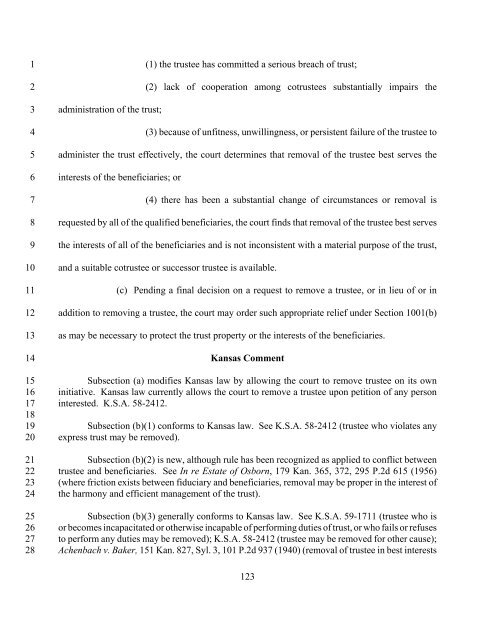uniform trust code - Kansas Judicial Branch
uniform trust code - Kansas Judicial Branch
uniform trust code - Kansas Judicial Branch
Create successful ePaper yourself
Turn your PDF publications into a flip-book with our unique Google optimized e-Paper software.
1<br />
2<br />
3<br />
4<br />
5<br />
6<br />
7<br />
8<br />
9<br />
10<br />
11<br />
12<br />
13<br />
14<br />
15<br />
16<br />
17<br />
18<br />
19<br />
20<br />
21<br />
22<br />
23<br />
24<br />
25<br />
26<br />
27<br />
28<br />
(1) the <strong>trust</strong>ee has committed a serious breach of <strong>trust</strong>;<br />
(2) lack of cooperation among co<strong>trust</strong>ees substantially impairs the<br />
administration of the <strong>trust</strong>;<br />
(3) because of unfitness, unwillingness, or persistent failure of the <strong>trust</strong>ee to<br />
administer the <strong>trust</strong> effectively, the court determines that removal of the <strong>trust</strong>ee best serves the<br />
interests of the beneficiaries; or<br />
(4) there has been a substantial change of circumstances or removal is<br />
requested by all of the qualified beneficiaries, the court finds that removal of the <strong>trust</strong>ee best serves<br />
the interests of all of the beneficiaries and is not inconsistent with a material purpose of the <strong>trust</strong>,<br />
and a suitable co<strong>trust</strong>ee or successor <strong>trust</strong>ee is available.<br />
(c) Pending a final decision on a request to remove a <strong>trust</strong>ee, or in lieu of or in<br />
addition to removing a <strong>trust</strong>ee, the court may order such appropriate relief under Section 1001(b)<br />
as may be necessary to protect the <strong>trust</strong> property or the interests of the beneficiaries.<br />
<strong>Kansas</strong> Comment<br />
Subsection (a) modifies <strong>Kansas</strong> law by allowing the court to remove <strong>trust</strong>ee on its own<br />
initiative. <strong>Kansas</strong> law currently allows the court to remove a <strong>trust</strong>ee upon petition of any person<br />
interested. K.S.A. 58-2412.<br />
Subsection (b)(1) conforms to <strong>Kansas</strong> law. See K.S.A. 58-2412 (<strong>trust</strong>ee who violates any<br />
express <strong>trust</strong> may be removed).<br />
Subsection (b)(2) is new, although rule has been recognized as applied to conflict between<br />
<strong>trust</strong>ee and beneficiaries. See In re Estate of Osborn, 179 Kan. 365, 372, 295 P.2d 615 (1956)<br />
(where friction exists between fiduciary and beneficiaries, removal may be proper in the interest of<br />
the harmony and efficient management of the <strong>trust</strong>).<br />
Subsection (b)(3) generally conforms to <strong>Kansas</strong> law. See K.S.A. 59-1711 (<strong>trust</strong>ee who is<br />
or becomes incapacitated or otherwise incapable of performing duties of <strong>trust</strong>, or who fails or refuses<br />
to perform any duties may be removed); K.S.A. 58-2412 (<strong>trust</strong>ee may be removed for other cause);<br />
Achenbach v. Baker, 151 Kan. 827, Syl. 3, 101 P.2d 937 (1940) (removal of <strong>trust</strong>ee in best interests<br />
123

















